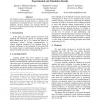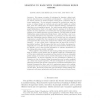281 search results - page 8 / 57 » Learning to Apply Theory of Mind |
NN
1998
Springer
13 years 7 months ago
1998
Springer
We experimented on task-level robot learning based on bi-directional theory. The via-point representation was used for ‘learning by watching’. In our previous work, we had a r...
HICSS
2007
IEEE
14 years 1 months ago
2007
IEEE
The authors present experimental and simulation results of an outcome-based learning model as it applies to the identification of emerging threats. This model integrates judgment,...
CORR
2010
Springer
13 years 7 months ago
2010
Springer
We develop a theory of online learning by defining several complexity measures. Among them are analogues of Rademacher complexity, covering numbers and fatshattering dimension fro...
NN
2008
Springer
13 years 7 months ago
2008
Springer
dely acknowledged that categorically organized abstract knowledge plays a significant role in high-order human cognition. Yet, there are many unknown issues about the nature of ho...
CORR
2008
Springer
13 years 7 months ago
2008
Springer
Abstract. We propose a number of techniques for learning a global ranking from data that may be incomplete and imbalanced -- characteristics that are almost universal to modern dat...


